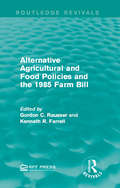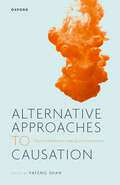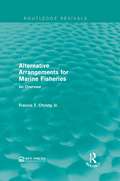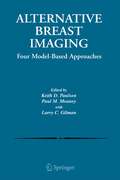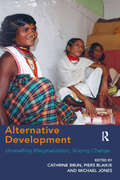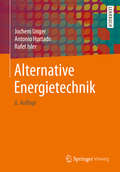- Table View
- List View
Alternating current sine wave (large print)
by RnibThis image shows the difference between alternating current and direct current in the form of waves. The image is a graph where the vertical axis represents the current's polarisation, while the horizontal axis represents time. The top section of the graph shows how direct current has a constant current polarisation over time. The bottom section shows how the currents polarisation for alternating current fluctuates over time, and forms a sine wave.
Alternative Agricultural and Food Policies and the 1985 Farm Bill (Routledge Revivals)
by Gordon C. Rausser Kenneth R. FarrellIn 1985, the U.S. Congress confronted the difficult and complex task of developing a 5-year omnibus legislation allowing for lower commodity prices. But, policies predicated on the concept of agriculture as a unique sector of the economy became less and less appropriate to the highly interdependent, open agricultural economy throughout the 1980s. First published in 1985, this collection of 16 papers and related discussions contained in these proceedings is an important contribution toward understanding the issues, options, and dilemmas in U.S. agricultural policy. This is an ideal title for students interested in environmental studies, agriculture, and national policy.
Alternative Agricultural and Food Policies and the 1985 Farm Bill (Routledge Revivals)
by Gordon C. Rausser Kenneth R. FarrellIn 1985, the U.S. Congress confronted the difficult and complex task of developing a 5-year omnibus legislation allowing for lower commodity prices. But, policies predicated on the concept of agriculture as a unique sector of the economy became less and less appropriate to the highly interdependent, open agricultural economy throughout the 1980s. First published in 1985, this collection of 16 papers and related discussions contained in these proceedings is an important contribution toward understanding the issues, options, and dilemmas in U.S. agricultural policy. This is an ideal title for students interested in environmental studies, agriculture, and national policy.
Alternative Antriebe für Automobile: Hybridsysteme, Brennstoffzellen, Alternative Energieträger
by Cornel StanDie vierte Auflage dieses Werkes präsentiert, auf Basis der neusten Forschungs- und Entwicklungsergebnisse sowie von Prototyp- und Serienausführungen, zukunftsweisende Antriebssysteme für Automobile – von Elektroantrieben mit Batterien oder Brennstoffzellen bis hin zu Plug In Hybridsystemen. Die Antriebskonzepte werden entsprechend der umgesetzten Prozesse und Funktionen analysiert und nach einheitlichen Kriterien wie spezifische Leistung, Drehmomentverlauf, spezifischer Kraftstoffverbrauch und Abgasemission bewertet. Die alternativen Kraftstoffe werden in Bezug auf Verfügbarkeit, Produktion, technischer Komplexität der Speicherung an Bord, Kosten, Sicherheit und Infrastruktur verglichen. Das Buch enthält Zusammenfassungen zu den bisher entstandenen Elektromobilen, Hybriden und Plug In Fahrzeugen. Die zukünftigen Antriebe für Automobile werden von Vielfalt geprägt sein – von den Lösungen für kompakte Stadtwagen, Mittelklassewagen, Fahrzeugen mit Reichweitenverlängerung und SUV’s bis hin zu preiswerten Mehrzweckwagen.
Alternative Approaches to Causation: Beyond Difference-making and Mechanism
by Yafeng ShanCausation is one of the most controversial topics in philosophy. There is a wide range of philosophical accounts of causation, for example, the regularity account, the probabilistic account, the counterfactual account, the interventionist account, which can be all classified as 'difference-making' accounts; and the mechanistic account. Many argue that only one of these accounts is correct as there is only one type of causal relation (causal monism), while others maintain that there are multiple types of causation (causal pluralism). In addition, there are eliminativists argue that science has no need of causation at all, while primitivists maintain that causation is unanalysable. Recently, the difference-making and mechanistic approaches have dominated recent philosophical discussion of causation. Other approaches and positions have been insufficiently discussed and assessed, especially in the context of philosophy of science. This volume explores and examines alternative approaches to causation. It revisits causal primitivism and causal eliminativism in the context of recent literature. It further explores the pluralistic approach, the fictionalist approach, the inferentialist approach, and the informational approach. It also examines the application of the dispositional approach, the epistemic approach, and the powerful particulars approach to the natural and social sciences. Overall, the volume is complementary to the recent discussion on the difference-making and mechanistic approaches and sheds new light on the metaphysical, epistemological, conceptual and methodological issues on causation. As such, it provides foundations for further research and teaching of this hotly debated topic.
Alternative Approaches to Causation: Beyond Difference-making and Mechanism
by Yafeng ShanCausation is one of the most controversial topics in philosophy. There is a wide range of philosophical accounts of causation, for example, the regularity account, the probabilistic account, the counterfactual account, the interventionist account, which can be all classified as 'difference-making' accounts; and the mechanistic account. Many argue that only one of these accounts is correct as there is only one type of causal relation (causal monism), while others maintain that there are multiple types of causation (causal pluralism). In addition, there are eliminativists argue that science has no need of causation at all, while primitivists maintain that causation is unanalysable. Recently, the difference-making and mechanistic approaches have dominated recent philosophical discussion of causation. Other approaches and positions have been insufficiently discussed and assessed, especially in the context of philosophy of science. This volume explores and examines alternative approaches to causation. It revisits causal primitivism and causal eliminativism in the context of recent literature. It further explores the pluralistic approach, the fictionalist approach, the inferentialist approach, and the informational approach. It also examines the application of the dispositional approach, the epistemic approach, and the powerful particulars approach to the natural and social sciences. Overall, the volume is complementary to the recent discussion on the difference-making and mechanistic approaches and sheds new light on the metaphysical, epistemological, conceptual and methodological issues on causation. As such, it provides foundations for further research and teaching of this hotly debated topic.
Alternative Arrangements for Marine Fisheries: An Overview (Routledge Revivals)
by Francis T. Christy, Jr.The maintenance of the freedom of fishing in the face of the changing circumstances that were occurring at the time of this title’s original publication in 1973 had produced several damaging consequences. It had led to considerable waste, in both biological and economic terms, and had been the source of increasing conflict. This waste can only be prevented by the adoption of management measures and by the removal of the condition of free and open access. This book explores various techniques for this, and will be of interest to students of environmental management.
Alternative Arrangements for Marine Fisheries: An Overview (Routledge Revivals)
by Francis T. Christy, Jr.The maintenance of the freedom of fishing in the face of the changing circumstances that were occurring at the time of this title’s original publication in 1973 had produced several damaging consequences. It had led to considerable waste, in both biological and economic terms, and had been the source of increasing conflict. This waste can only be prevented by the adoption of management measures and by the removal of the condition of free and open access. This book explores various techniques for this, and will be of interest to students of environmental management.
Alternative Breast Imaging: Four Model-Based Approaches (The Springer International Series in Engineering and Computer Science #778)
by Keith D. Paulsen Paul M. Meaney Larry GilmanMedical imaging has been transformed over the past 30 years by the advent of computerized tomography (CT), magnetic resonance imaging (MRI), and various advances in x-ray and ultrasonic techniques. An enabling force behind this progress has been the (so far) exponentially increasing power of computers, which has made it practical to explore fundamentally new approaches. In particular, what our group terms "model-based" modalities-which produce tissue property images from data using nonlinear, iterative numerical modeling techniques-have become increasingly feasible. Alternative Breast Imaging: Four Model-Based Approaches explores our research on four such modalities, particularly with regard to imaging of the breast: (1) MR elastography (MRE), (2) electrical impedance spectroscopy (EIS), (3) microwave imaging spectroscopy (MIS), and (4) near infrared spectroscopic imaging (NIS). Chapter 1 introduces the present state of breast imaging and discusses how our alternative modalities can contribute to the field. Chapter 2 looks at the computational common ground shared by all four modalities. Chapters 2 through 10 are devoted to the four modalities, with each modality being discussed first in a theory chapter and then in an implementation-and-results chapter. The eleventh and final chapter discusses statistical methods for image analysis in the context of these four alternative imaging modalities. Imaging for the detection of breast cancer is a particularly interesting and relevant application of the four imaging modalities discussed in this book. Breast cancer is an extremely common health problem for women; the National Cancer Institute estimates that one in eight US women will develop breast cancer at least once in her lifetime. Yet the efficacy of the standard (and notoriously uncomfortable) early-detection test, the x-ray mammogram, has been disputed of late, especially for younger women. Conditions are thus ripe for the development of affordable techniques that replace or complement mammography. The breast is both anatomically accessible and small enough that the computing power required to model it, is affordable.
Alternative Development: Unravelling Marginalization, Voicing Change
by Cathrine Brun Piers BlaikieThis book brings together a collection of essays that discuss alternative development and its relevance for local/global processes of marginalization and change in the Global South. Alternative development questions who the producers of development knowledges and practices are, and aims at decentring development and geographical knowledge from the Anglo-American centre and the Global North. It involves resistance to dominant political-economic processes in order to further the possibilities for non-exploitative and just forms of development. By discussing how to unravel marginalization and voice change through alternative methods, actors and concepts, the book provides useful guidance on understanding the relationship between theory and practice. The main strength of the book is that it calls for a central role for alternative development in the current development discourse, most notably related to justice, rights, globalization, forced migration, conflict and climate change. The book provides new ways of engaging with alternative development thinking and making development alternatives relevant.
Alternative Development: Unravelling Marginalization, Voicing Change
by Cathrine Brun Piers BlaikieThis book brings together a collection of essays that discuss alternative development and its relevance for local/global processes of marginalization and change in the Global South. Alternative development questions who the producers of development knowledges and practices are, and aims at decentring development and geographical knowledge from the Anglo-American centre and the Global North. It involves resistance to dominant political-economic processes in order to further the possibilities for non-exploitative and just forms of development. By discussing how to unravel marginalization and voice change through alternative methods, actors and concepts, the book provides useful guidance on understanding the relationship between theory and practice. The main strength of the book is that it calls for a central role for alternative development in the current development discourse, most notably related to justice, rights, globalization, forced migration, conflict and climate change. The book provides new ways of engaging with alternative development thinking and making development alternatives relevant.
Alternative Ecological Risk Assessment: An Innovative Approach to Understanding Ecological Assessments for Contaminated Sites
by Lawrence V. TannenbaumIn Alternative Ecological Risk Assessment the author, Lawrence V. Tannenbaum, provides a critical review of current practices in the ecological risk assessment field and proposes alternatives that are supported by established science and keen observation. It is hoped that this approach will pave the way to a greater understanding of what appropriate and useful ecological assessment for contaminated sites should entail. He demonstrates that in most cases current practices do not provide for an assessment of ecological risk, and moreover, that endeavoring to assess ecological risk is actually an unnecessary undertaking at conventional hazardous waste sites. (He states, for example, that the concept of scale is often ignored by practitioners, questions why animals like deer are routinely assessed at 5-acre sites, and challenges the ecotoxicology data currently used.) The book is aimed at students and professionals in the fields of environmental science, ecology, ecotoxicology, and health risk assessment.
Alternative Ecological Risk Assessment: An Innovative Approach to Understanding Ecological Assessments for Contaminated Sites
by Lawrence V. TannenbaumIn Alternative Ecological Risk Assessment the author, Lawrence V. Tannenbaum, provides a critical review of current practices in the ecological risk assessment field and proposes alternatives that are supported by established science and keen observation. It is hoped that this approach will pave the way to a greater understanding of what appropriate and useful ecological assessment for contaminated sites should entail. He demonstrates that in most cases current practices do not provide for an assessment of ecological risk, and moreover, that endeavoring to assess ecological risk is actually an unnecessary undertaking at conventional hazardous waste sites. (He states, for example, that the concept of scale is often ignored by practitioners, questions why animals like deer are routinely assessed at 5-acre sites, and challenges the ecotoxicology data currently used.) The book is aimed at students and professionals in the fields of environmental science, ecology, ecotoxicology, and health risk assessment.
Alternative Education for the 21st Century: Philosophies, Approaches, Visions
by P. WoodsThis is a unique collection of leading examples of education grounded in alternative philosophies and cultures – from initiatives to create more democratic schools, through Quaker, Buddhist, Islamic, Montessori and Steiner/Waldorf schools, to Maori and First Nations education in Canada and Palestinian Jewish schools in Israel.
Alternative Energies: Updates on Progress (Advanced Structured Materials #34)
by Germán FerreiraThis book presents nine chapters based on fundamental and applied research of alternative energies. At the present time, the challenge is that technology has to come up with solutions that can provide environmentally friendly energy supply options that are able to cover the current world energy demand. Experts around the world are working on these issues for providing new solutions that will break the existing technological barriers. This book aims to address key pillars in the alternative energy field, such as: biomass energy, hydrogen energy, solar energy, wind energy, hydroelectric power, geothermal energy and their environmental implications, with the most updated progress for each pillar. It also includes the life cycle assessment (LCA) and thermoeconomic analysis (TA) as tools for evaluating and optimising environmental and cost subjects. Chapters are organized into fundamental research, applied research and future trends; and written for engineers, academic researches and scientists.
Alternative Energietechnik
by Jochem UngerDer Hauptinhalt des vorliegenden Buches ist neben technisch wichtigen Auslegungs- und Sicherheitskriterien für konventionelle, nukleare und regenerative Energiesysteme das Erkennen, das Beurteilen und Berücksichtigen der vom menschlichen Wirtschaften verursachten Rückwirkungen, das prinzipielle Problem der Nicht-Quantifizierbarkeit umweltrelevanter Entscheidungskriterien und Auswege aus diesem Dilemma. Zusätzlich werden aber auch gesellschaftspolitische Aspekte ins Spiel gebracht, die selbstorganisierend vom darwinistischen Wirtschaften hin zu einem humanen volkswirtschaftlichen Prozess führen, der das ökologische Minimalprinzip gerade vollständig ausschöpft. Die anschauliche Darstellung der Sachverhalte mit Hilfe einfachster mathematischer Modelle setzt nur elementare Kenntnisse der Mathematik und der jeweils relevanten Fachdisziplinen voraus. Zur Vertiefung und Übung sind zahlreiche Aufgaben mit Angabe des Lösungswegs beigefügt. Das Buch wurde für die neue Auflage vollständig überarbeitet. Insbesondere wurden die technischen Aspekte dieses in rasanter Bewegung befindlichen Gebietes auf den neuesten Stand gebracht.
Alternative Energietechnik
by Jochem Unger Antonio HurtadoDieses Lehrbuch vermittelt die technischen Grundlagen sowie wichtige Auslegungs- und Sicherheitskriterien für konventionelle, nukleare und regenerative Energiesysteme. Es zeigt die Auswirkungen des menschlichen Wirtschaftens, erklärt wie diese zu beurteilen und zu berücksichtigen sind. Es zeigt die möglichen Auswege auf, auch wenn umweltrelevante Entscheidungskriterien prinzipiell nicht quantifizierbar sind. Zusätzlich werden auch gesellschaftspolitische Aspekte angesprochen, die zu einem humanen volkswirtschaftlichen Prozess hinführen, der das ökologische Minimalprinzip gerade vollständig ausschöpft. Die anschauliche Darstellung der Sachverhalte mithilfe einfachster mathematischer Modelle setzt nur elementare Kenntnisse der Mathematik und der jeweils relevanten Fachdisziplinen voraus. Für Vertiefung und Übung sind zahlreiche Aufgaben mit den jeweiligen Lösungswegen beigefügt.
Alternative Energietechnik
by Jochem Unger Antonio HurtadoDer Hauptinhalt des vorliegenden Buches ist neben technisch wichtigen Auslegungs- und Sicherheitskriterien für konventionelle, nukleare und regenerative Energiesysteme das Erkennen, das Beurteilen und Berücksichtigen der vom menschlichen Wirtschaften verursachten Rückwirkungen, das prinzipielle Problem der Nicht-Quantifizierbarkeit umweltrelevanter Entscheidungskriterien und Auswege aus diesem Dilemma. Zusätzlich werden aber auch gesellschaftspolitische Aspekte ins Spiel gebracht, die selbstorganisierend vom darwinistischen Wirtschaften hin zu einem humanen volkswirtschaftlichen Prozess führen, der das ökologische Minimalprinzip gerade vollständig ausschöpft. Die anschauliche Darstellung der Sachverhalte mit Hilfe einfachster mathematischer Modelle setzt nur elementare Kenntnisse der Mathematik und der jeweils relevanten Fachdisziplinen voraus. Zur Vertiefung und Übung sind zahlreiche Aufgaben mit Angabe des Lösungswegs beigefügt.
Alternative Energietechnik
by Jochem Unger Antonio Hurtado Rafet IslerDieses Lehrbuch vermittelt die technischen Grundlagen sowie wichtige Auslegungs- und Sicherheitskriterien für konventionelle, nukleare und regenerative Energiesysteme. Es zeigt die Auswirkungen des menschlichen Wirtschaftens, erklärt wie diese zu beurteilen und zu berücksichtigen sind. Es zeigt die möglichen Auswege auf, auch wenn umweltrelevante Entscheidungskriterien prinzipiell nicht quantifizierbar sind. Zusätzlich werden auch gesellschaftspolitische Aspekte angesprochen, die zu einem humanen volkswirtschaftlichen Prozess hinführen, der das ökologische Minimalprinzip gerade vollständig ausschöpft. Die anschauliche Darstellung der Sachverhalte mithilfe einfachster mathematischer Modelle setzt nur elementare Kenntnisse der Mathematik und der jeweils relevanten Fachdisziplinen voraus. Für Vertiefung und Übung sind zahlreiche Aufgaben mit den jeweiligen Lösungswegen beigefügt.
Alternative Energy (Historical Guides to Controversial Issues in America)
by Brian C. Black Richard FlarendAn exceptionally timely volume that weighs the costs and benefits of alternative energy sources and their implications for reducing energy consumption.As this book makes clear, civilization cannot long continue to ride on an oil slick. Worldwide, many people have come to see dependence on coal, and especially on oil, not only as unsustainable, but as profoundly destabilizing, both environmentally and politically. While ever-increasing demands continue to be placed on "mainstream" energy sources, recurring attempts have been made to generate power in "alternative" ways. After retracing some of these efforts, this succinct and historically informed volume explores the ongoing debate over alternative energy that gathered strength in the 20th century, showing how that debate mirrors larger attitudes toward energy and consumption. Like other volumes in this series, Alternative Energy is designed to provide material for student reports and debate arguments. It is an outstanding sourcebook for those interested in investigating the problems and prospects of alternative fuels.
Alternative Energy For Dummies
by Rik DeGuntherThe myths and facts about alternative fuels–and how they impact our lives As the price of energy continues to soar, so too has the demand for alternative energy. But there's no clear "winner" in the race to replace fossil fuels. Alternative Energy For Dummies explores the current fossil fuel conundrum and society's growing need for more and more energy. Cutting through the competing claims, this book offers a multifaceted examination of alternative energy, including solar, wind, nuclear, biomass, geothermal, biofuel, and other sources. Each alternative scenario is compared to current fossil-fuel intensive practices in the scientific, environmental, social, political, and economic realms. Readers also gain insight into the future of energy production.
Alternative Energy For Dummies
by Rik DeGuntherThe myths and facts about alternative fuels–and how they impact our lives As the price of energy continues to soar, so too has the demand for alternative energy. But there's no clear "winner" in the race to replace fossil fuels. Alternative Energy For Dummies explores the current fossil fuel conundrum and society's growing need for more and more energy. Cutting through the competing claims, this book offers a multifaceted examination of alternative energy, including solar, wind, nuclear, biomass, geothermal, biofuel, and other sources. Each alternative scenario is compared to current fossil-fuel intensive practices in the scientific, environmental, social, political, and economic realms. Readers also gain insight into the future of energy production.
Alternative Energy Resources: The Way to a Sustainable Modern Society (The Handbook of Environmental Chemistry #99)
by Pankaj Pathak Rajiv Ranjan SrivastavaThis book reviews alternative and renewable energy resources in order to pave the way for a more sustainable production in the future. A multi-disciplinary team of authors provides a comprehensive overview of current technologies and future trends, including solar technologies, wind energy, hydropower, microbial electrochemical systems and various biomass sources for biofuel production. In addition, the book focuses on solutions for developing countries. Conventional energy sources are finite, and estimates suggest that they will be exhausted within a few decades. Finding a solution to this problem is a global challenge, and developing countries in particular are still highly dependent on fossil fuels due to their rapidly growing populations accompanied by a huge growth in primary energy consumption. Moreover, the most common conventional energy sources (coal and petroleum) are non-sustainable since their combustion exponentially increases greenhouse gas emissions. As such, there is a pressing need for clean energy based on alternative or renewable resources, not only to ensure energy supplies at an affordable price but also to protect the environment.


